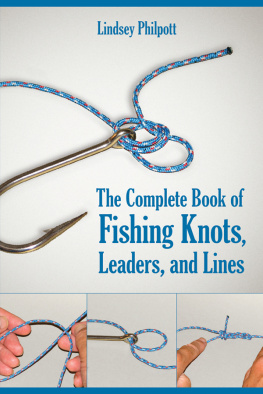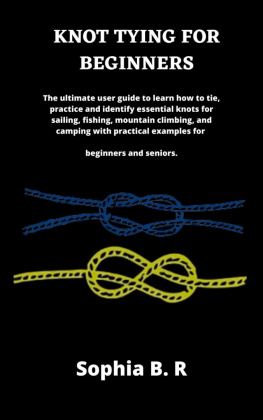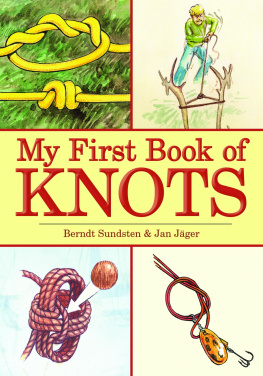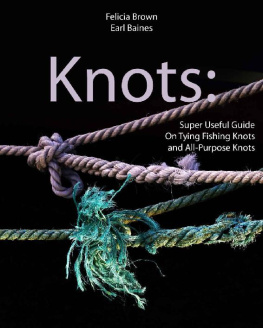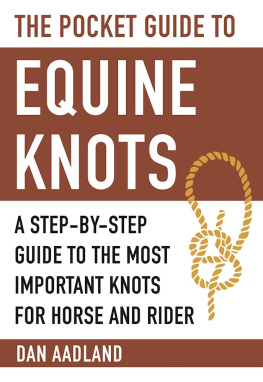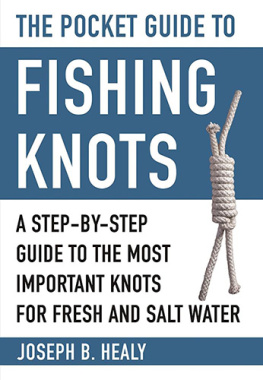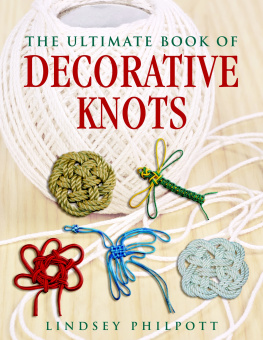Copyright 2008 by Lindsey Philpott
All rights reserved. No part of this book may be reproduced in any manner without the express written consent of the publisher, except in the case of brief excerpts in critical reviews or articles. All inquiries should be addressed to Skyhorse Publishing, 307 West 36th Street, 11th Floor, New York, NY 10018.
Skyhorse Publishing books may be purchased in bulk at special discounts for sales promotion, corporate gifts, fund-raising, or educational purposes. Special editions can also be created to specifications. For details, contact the Special Sales Department, Skyhorse Publishing, 307 West 36th Street, 11th Floor, New York, NY 10018 or .
Skyhorse and Skyhorse Publishing are registered trademarks of Skyhorse Publishing, Inc., a Delaware corporation.
Visit our website at www.skyhorsepublishing.com.
10 9 8 7 6 5 4 3 2 1
Philpott, Lindsey.
The complete book of fishing knots, leaders, and lines / Lindsey Philpott.
p. cm.
Includes bibliographical references and index.
(pbk. : alk. paper)
1. Fishing knots. 2. Leaders (Fishing) 3. Fishing lines. I. International
Game Fish Association. II. Title.
SH452.9.K6P45 2008
799.12dc22
2007050476
Cover design by DILON
Photographs by Jimmy Ray Williams and Ben Philpott
Print ISBN: 978-1-63220-536-0
Ebook ISBN: 978-1-63220-939-9
Printed in China
Contents
Chapter 5
Acknowledgments
The author is greatly indebted to the following for their advice, encouragement, and leadership, particularly in allowing the author free rein with his sometimes scattered and witless rantings about knots. To my wife, Kim, for having the tenacity and forbearance to put up with me; to my sons Nick and Ben for their able and willing assistance, especially Ben who took many of the photographs you see here; to my friend and knotting companion, Jimmy Ray Williams, who also was kind enough to lend his skills in taking photographs throughout the book; to the Joes, Charlies, Toms, Gordons, Jeffs, Kens, and countless others of the International Guild of Knot Tyers both here and abroad, who have by their own efforts far outstripped any small efforts I have made; and to all those to whom I have made mention of my passion, knotting, and who have nodded sagely and then wisely stepped aside to allow me to get on with it. Last, but by no means least, the author wishes to thank the understanding and forbearing editorial and publishing crew at Skyhorse for having brought so much gold out of so much dross. Thank you all.
Chapter 1
What You Need to Know About Knots
As anglers we are the first to admit that we have favorite fishing knots for different situations, and only those knots will dowe swear by them and would not change for all the tea in China. We grow accustomed to tying a particular knot in the type of line we prefer and do not want to change our familiar methods. Because we have this history with knots and line, we have definite ideas about which knots and lines work best and where they work best, so what could there possibly be that you need to know about the subject? Read on.
Tying knots in line, particularly slick line like monofilament, has always been a challenge. All record-setting anglers agree that they had to learn their knots first, along with a thorough familiarity of lines and other equipment. It is neither staying out of the weeds and rocks, finding the perfect bait, nor even staying out of the trees or snags that presents the record seeker with the greatest challenge. At the outset, tying good, reliable knots is the greatest challenge. The line seems thin, slick, and fiddlyit seems to have a mind of its own. But it has to be mastered if you are to keep up with the recordsetters. With practice, you can certainly master the necessary skills. With practice, you can show others those skills and go on to learn, or perhaps even invent your own knots.
When you are peacefully practicing knot tying you have all the time in the world. But see a rise and you have to know which knot to tie and you have to tie it now. Having learned and practiced ahead of time will serve you well. You will have confidence that the hook and line will remain together on that 20-pounder.
Here Ill present at least three of the secrets to tying good knots that stay tied. Practicing them before you go, seated in your comfy chair with this book at your side, will help you to gain skill and confidence.
The first secret to tying knots is no secret reallyyou have to pick the right knot, or the fish is lost before you make your first cast. If your knot looks ragged, it will snag before it hits the water. If your knot is lumpy, it will be visible to fish for mileswell, yards anyway. Worse yet, if your knot has to pass through small-diameter rod guides and you have tied the right knot, but in the wrong direction, you could end up spending valuable time untangling snarled line.
You should seek out advice wherever you can regarding which knots work best for what you doing. You have taken the right first step in picking up this book. Get advice from your fishing buddies, captains and guides, the storeowner where you get your tacklethey are all good sources of information. Just a friendly word though: dont rely on their advice alone. Consider what they are saying and make up your own mind.
The second secret that I want to share is that life does not stand still. You will have to grow with it, whether you want to or not. Fishing, as part of life, is not a sport that likes to stay still: it is constantly evolving. New lines are coming out all the time, new rods, new reels, new gearthere is always something new. Your knots, however, having stood the test of time, have not changed in maybe five or ten years, maybe even since you first tied them? So, do you think that maybe there is something you could stand to learn about knots, even if you choose not to use the information? If you can gain some greater understanding of how knots work, and in which kinds of line, wouldnt that be worth hanging onto? Before you answer, lets consider the third big secret.
When a New York cabbie was asked by a breathless young woman running to his taxi from Grand Central Station, with a violin case gripped white-knuckle tight in her hand, Whats the best way to get to Carnegie Hall? he laconically replied, Practice, practice, practice. Its not my joke, but thats my advice, in a nutshell, the third secret. You must practice or you will get to be like that garden rake you havent used in yearsrusty. When you do practice, try tying a new knot by first following all the directions. Then see if you can find some shortcuts or missed steps that you need to know about. Practice will help your fingers remember the moves, and once the moves are memorized, you may discover new and different ways of holding the line when tying the Blood Knot, or Bimini Twist, so that you do not let go at a crucial moment, or you do not twist something too much or too little. Remember that different line materials will affect the way a certain knot should be tied. Whether it is too many twists or too fewthere is going to be something different about it, so be alert.
Before we get started in earnest, take a look at the complete Glossary of Terms toward the end of the book. Familiarity with the names for the parts of knots and line will help you get started. Here are a few critical ones.
Knot Terminology
Line: Any piece of flexible material made of man-made (usually) or organic (not much these days) fibers, used, in our case, for catching fish. It may also be a piece of wire, but dont let that fool youit is still referred to as line.

